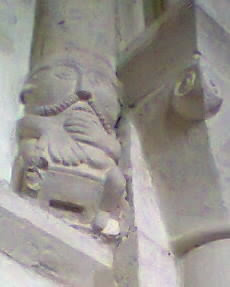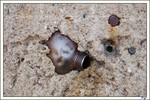This chap is one of a small band of grotesques who support the vaults in the little Romanesque church of Saint-Martin, Tollevaste, deep in the pastoral-bosky-richly hedgerowed landscape of Cotentin. This unspoilt church, with its array of inventively carved corbels and capitals owing far more to paganism than Christianity, was but one of the highlights of my latest Norman jaunt (how inexhaustible is Normandy, let alone France!). Here are some others...
In Cherbourg, in the church of Ste Trinité (much fine Flamboyant stonework), a set of exquisitely carved panels in Nottingham alabaster, from the original altar - a reminder of English Normandy.
Also in Cherbourg, the Café de Paris - a name that always seems to denote either a very bad restaurant or a very good one. In Cherbourg's case, it's the latter - a really excellent mid-range 'bourgeois' restaurant. If you find yourself in Cherbourg - a town full of interest but with none of the easy-going charm of Dieppe - head for the Café de Paris and you'll be fine.
Another church - Saint-Martin, Réville, with its tall tower, standing imposingly on a rocky mound, the little town on one side and the sea on the other. Another fine Norman interior. Then, by way of a change, along the coast at Saint-Vaast-La-Hougue, there's a wonderfully correct and convincing mid-19th-century recreation of a 13th-century cathedral. There were also...
Oysters, eaten in an unpretentious restaurant next to a poissonnerie. These were some of the finest I've ever had. The oysters of Saint-Vaast are renowned in Normandy, and no wonder. Later, walking through a spinney, we found we were making our clattering way along a path surfaced for a couple of hundred yards with oyster shells - thousands upon thousands of them.
Bricquebec, an inland town dominated by the remains of its medieval castle. In the bailie stands the kind of thing I normally don't warm to at all, but in this case... It's called the Pyramide de Mémoire and is a concrete pyramid composed of sand from Utah Beach, in which have been embedded some 2,000 objects, remnants of warfare - bullets and shell casings, helmets, jerry cans, engine parts, canteens, pieces of shrapnel. The friable texture of the concrete means that gradually, over the years, it is wearing away, exposing new objects little by little as they emerge from their entombment. Eventually all those objects will appear, come free of their setting, and the pyramid itself - the work itself - will erode away to nothing. It's a rather brilliant idea, and the pyramid, with its embedded relics gradually emerging, is strangely moving. A notice instructs anyone detaching an object from the pyramid to take it to the Mairie so that it can be passed on to the local Musée.
Subscribe to:
Post Comments (Atom)



Isn't that flamBoyant Nige, in French or English. Expect its a typo. A French teacher can't let that one go though. Thanks for the vicarious tour though.
ReplyDeleteIt is indeed - thanks Guy! Duly corrected...
ReplyDelete